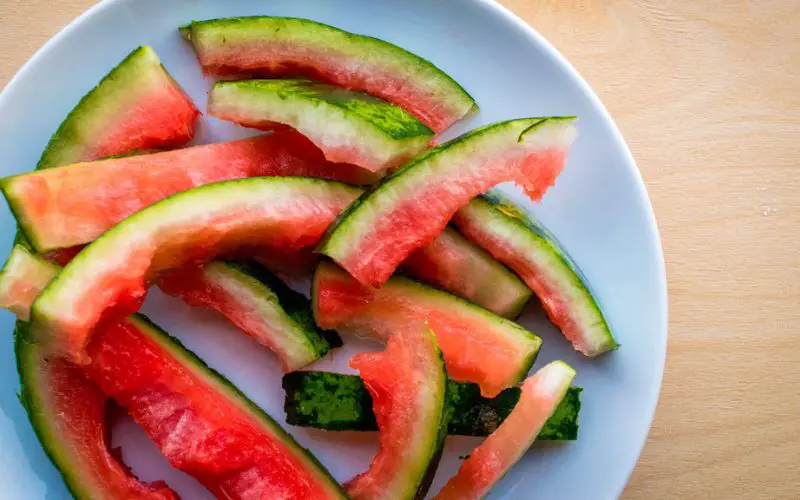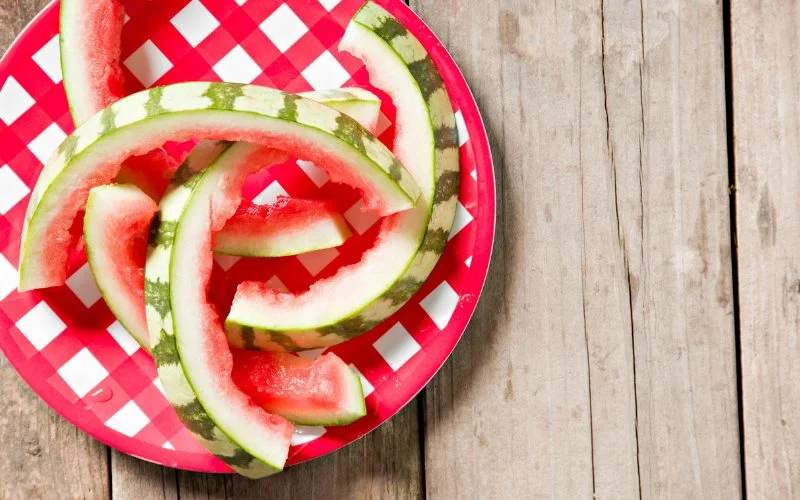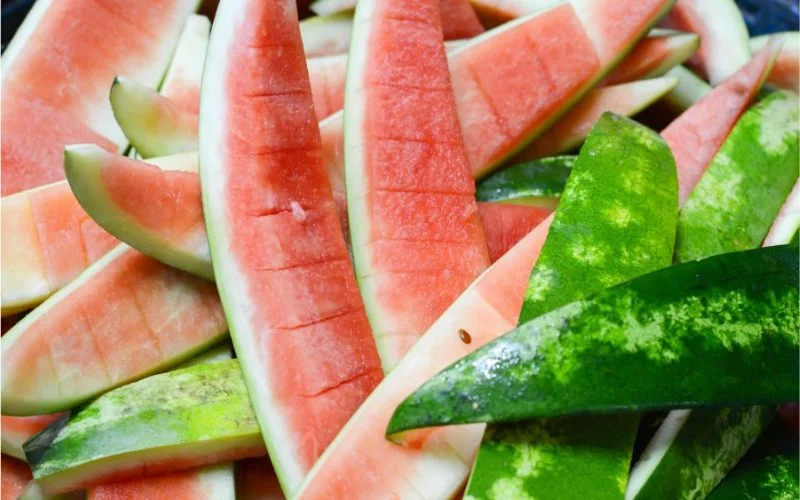When we eat our water, like the sweet and delicious core of the watermelon, we are left with many rinds that quickly fill our garbage bin, especially in the summer. If you wonder if you can turn those watermelon rinds into compost, the answer is affirmative.
You can compost your watermelon rinds, but before you do that, you must chop them up in smaller chunks so they can break down easily in the compost bin. It is essential because watermelon rinds are challenging and, if left whole, will compost too slowly.
Today, we bring you instructions on how you can compost watermelon.
Can You Compost Watermelon Rind? (Yes, Here is How)

Anyone can dump their watermelon rind in a compost bin and leave it there. Well, it will eventually turn into compost, but there is a better way to go about it – and here is how to:
Cut The Watermelon Rind Into Smaller Pieces
It is one of the most critical steps when composting bulky and rigid materials like watermelon rind. Chopping up the watermelon rind helps to create more surfaces for microbes to act on. It also helps to create a more homogeneous compost with evenly distributed ingredients in a pile.
You can equally put the watermelon seeds into a food processor to break them apart easily. Alternatively, you can use a mallet or hammer to open the casing so the seeds can compost faster. It is essential because watermelon seeds are plenty, and they might take many months to decompose. Secondly, if the whole seed is left alone in the compost pile, it will often germinate.
Get Rid Of As Much Juice As Possible
You don’t need a lot of water in your compost pile, and as the name suggests, watermelon has a high percentage of water in it, so before you compost your watermelon rind, you must try to remove the excess fluid. To reduce the amount of moisture going into your compost bin, drain your watermelon pieces and pour the scraps into a strainer so the juices can drip out before bringing them to your compost pile. Alternatively, you can spread the watermelon pieces onto a flat tray and leave them in the sun for about 2 hours to dry up the juice.
Balance The Watermelon With Brown Compost Ingredients
Before adding the watermelon pieces to your compost pile, you should use an s moisture meter to determine how dry the material is to know the right amount of brown or carbon-rich compost materials to add that will balance the watermelon you are adding. It is to prevent the compost pile from getting too wet.
The amount of brown to green (these are compost ingredients compost material that is rich in nitrogen like watermelon) generally should be in the ratio of 3:1. If you’re starting a new compost pile and using watermelon as a significant ingredient, then ensure you add a lot of dry leaves, straw, or cardboard that can soak up all those excess juice t and also keep the pile from immediately getting slimy and attracting pests.
If you are starting a fresh compost pile, you must mix in some compost starter like some manure or compost to provide beneficial organisms to speed up the process.
Turn the Compost Often To Aerate It.
The microbes in your compost pile, the workers that convert your kitchen scrap like a watermelon into nutrient-rich compost, need oxygen to survive, so you must turn your compost in the tumbler or bin at least once every 4 to 5 days.
If your compost pile is outside, you can dig it down with your garden fork to the center of the bank and lift the material to the surface while pushing outward. You should take compost material from the outer edges of the pile and dump it into the middle to decompose at the same rate.
If you are using a compost tumbler, give the drum several spins to mix up the contents, while for a compost bin, you should use a compost-turning tool that will not create a mess in the process turning the compost.
So What If I Decide To Eat My Watermelon Rind?
For some, this sounds like a question – who wants to eat the rigid back of the watermelon after enjoying the soft pink flesh? The truth is that, YES, you can eat watermelon rinds because they are edible. While watermelon rinds are not as delicious as the soft interior, it is still chewy and delicious. A common way people eat watermelon rinds is to pickle them first. It is tasty that way.
While many people trash their watermelon rind while others recycle it in their compost bin, eating the watermelon rind is very nutritious because it contains an amino acid called citrulline which has been shown to have a lot of health benefits like the promotion of healthy blood vessels, boosting athletic performance and even your libido, and also lowers blood pressure. Watermelon rind is also a rich source of fiber which aids digestion and impacts our weight positively too.
Benefit Of Turning Watermelon Into Compost

Making compost is environmentally friendly water for turning your trash into treasure. So many benefits accrue to you and our environment when you turn your watermelon or any other waste into compost. Here are some of these benefits:
It Saves You Money
If you have a garden, you will already know that the cost of manure and fertilizer is appreciable, accounting for a reasonable percentage of the cost of gardening. If you can produce your manure by composting the scrap from your kitchen, like watermelon rinds, you will save a reasonable amount of money.
It Adds Nutrient To The Soil
Compost is rich in humus and contains many nutrients that plants require to thrive. Talk of nutrients and elements like nitrogen which green compost material add to the soil, and the carbons-rich brown compost ingredients which plants require to grow and stay healthy. All this compost, when added to the soil, yields plants.
It helps The Water Retention Of The Soil.
If your garden quickly drains out the water, what you will have is the soul that is always dry, which means you will have to water it more often than usual. But with the addition of the compost you made from watermelon or any other compost, the compost binds the soil particles to retain more water.
Compost Introduces Beneficial Microbes Into the Soil
There are lots of different microbes that are beneficial to plants that are found in the soil. These bacteria carry out different complex activities that keep the systems in the soil going. Compost Introduces these beneficial organisms to the soil. Microorganisms, such as bacteria, fungi, and protozoa, help decompose organic material and convert it into plant nutrients.
Compost Reduces Landfill Waste.
Ultimately, most of our waste ends up in landfill, and you remember that in our world today, more and more trash is being generated daily, and end up in landfill and sometimes even cause pollution on the land. But when we compost some of our trash, like watermelon rind, we can significantly reduce the waste that goes to landfill.
Using Compost is Environmentally Friendly.
Suppose you use something other than organic fertilizers like manure and compost. In that case, your only option is to rely on factory-made fertilizers and chemicals, which harm our environment. These fertilizers and chemicals can wash into our water bodies, polluting the water. You don’t compound this problem if you use compost.
Conclusion
One of the most common fruits we love to eat in summer is watermelon because this very delicious fruit also has a high percentage of water and rind. You may also want to check out How to Make Homemade Compost Catalyst.
Helpful Links:
- Can You Compost Pineapple?
- How Do You Grind Compost?
- How To Compost Corn Plants
- Can Paper Towels Be Composted?
- Can I Compost Any Material I Find?
- Best Composting Grinder for Home Use
Watermelon rinds are bulky and can quickly fill up the trash, but this watermelon can be recycled by turning it into compost. Turning watermelon rind into compost is easy and also beneficial. Why not try it today
Thanks for taking the time to read our article, and we hope you find it helpful. Would you mind leaving a comment below if you have any suggestions?
Kindly reach out to people by sharing this post on social media.
If you liked this article, then please follow us on Facebook, Instagram, and Pinterest.

